Article
Stiffs, Skulls & Skeletons: A Burns Book Review
Author(s):
A new book highlights the history of the medical profession through vintage photographs, but it also illuminates the changes that have taken place in how we think about medical education and privacy.
All Photographs by Author © Stanley B. Burns, MD & The Burns Archive
New York City ophthalmologist, Stanley B. Burns. MD, FACS has done it again: the Burns Archive has produced a Schiffer Special Edition 2015 coffee table volume of historical medical photographs, in cooperation with his daughter Elizabeth, an author and publisher in her own right. She has curated many of the Burns Archive exhibitions.
STIFFS, SKULLS & SKELETONS Medical Photography and Symbolism is Stanley Burns’ 43rd book.
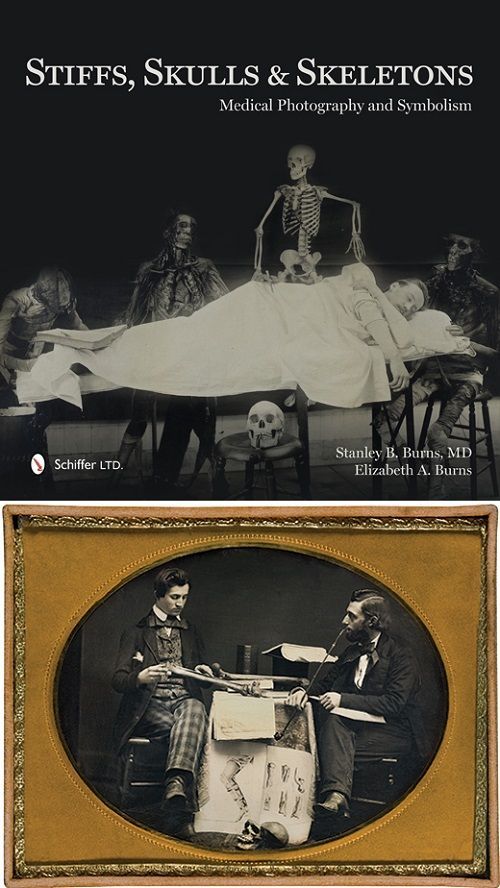
The book’s cover uses a 1906 photograph by A.A. Robinson to show the theoretical concept of the previous century, “magical substitution,” wherein viewers would place themselves within a depicted theme. Says Burns, “It is one source of empathy, as one contemplates even fleetingly what it would mean to be in that situation.” The back cover has a rare 1855 commemorative daguerreotype showing a medical school professor, Charles Linnaeus Allen. MD, studying anatomy in Vermont with a physician, Daniel Avery, MD.
Although the book has more than 400 rare photographs—and at a size of 12 inches by 12 inches with 328 pages is more like an atlas than a mere book—much of the reader’s fascination comes from the medical history that emerges effortlessly from the knowledge of the 2 authors. The authors have cast over our profession to collect the more than one million historical medical photographs (many unpublished) in the Burns Archive that “offer fresh relief from the clichéd pictures that all too often populate many medical history works.”

For example, where else would a medical student or a physician of today see a rickets skeleton dated 1879 from the very museum of Dupuytren himself? Dupuytren! Napoleon’s surgeon!
Burns is that special teacher who makes his readers think and their minds expand. Guillaume Dupuytren started medical school in Paris at the age of 12 and died in 1835 aged 58 with a lung empyema that he, the greatest and richest surgeon in France, declined to have drained. Rickets, Burns captions his photograph to tell us, was first described in Leiden, Netherlands in 1645 but its cause not identified as a dietary deficiency disease until 1918. Sir Edward Mellanby discovered Vitamin D the next year and showed rickets was curable with a proper diet—and no one was more determined to force Dr. Schutte’s cod liver oil down the throats of her 2 boys than my mother. So already Dr. Burns has his readers engaged before they’ve read 8 pages.
The deadly epidemics that ravaged Europe from the 14th century onwards created “a daily life that was never free of death,” says Burns, quoting Philippe Aries, a French medievalist who wrote widely on Western attitudes towards death. Families were accustomed to the presence of death and photography offered an opportunity for family members to be memorialized with the deceased: a mother holding her dead child, a daughter in the lap of her dead father. The images shown remind us that privacy was fugitive in the 19th century. Before we had HIPAA rules there was little concern for the identity of a medical subject.
So we see photographs of:
- Phrenologists including Lorenzo Fowler, the “leading phrenologist of his time” studying anatomy
- Medical schools displaying osteology as an advertisement
- Medical students posing with skulls and bone saws
- And the recently-departed lying in post mortem tributes
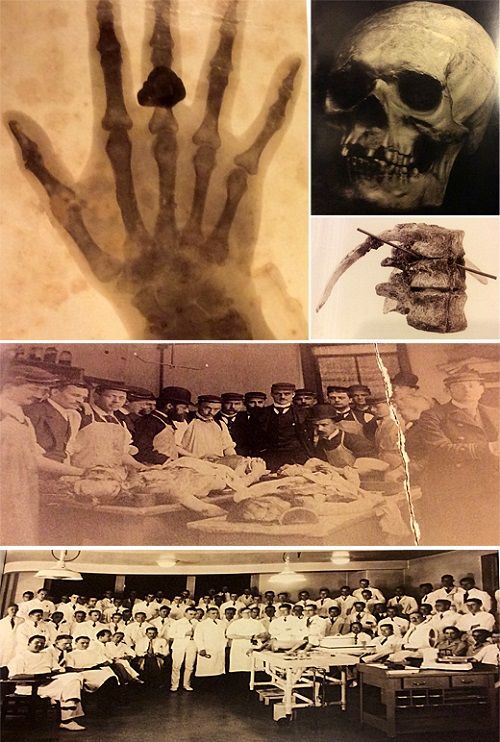
The images (copyright Stanley B. Burns, MD & the Burns Archive) are sharper in the book but—used here in this review to make a point—they are sometimes a detail of the original image.
The Burns Archive illustrations in Stiffs, Skulls & Skeletons show readers photographs of significant and specific anatomical or historical interest. For example, we see (top left clockwise) the 1896 radiograph of the hand of Conrad Roentgen’s wife (the first X-Ray ever taken), the 1827 skull of Ludwig Van Beethoven, and the 1881 autopsy picture of President Garfield’s vertebra, an image perhaps more poignant for physicians given its title, “Shot by an Assassin, But Killed by Physicians.” True, Garfield’s doctors didn’t understand sepsis and sterilization procedures but the assassin, Charles J. Guiteau, may have nailed it in court when he told the judge: “I deny the killing, if your honor please. We admit the shooting.” (For details click here. Great works of non-fiction do this: they make readers explore beyond the pages in additional search for knowledge.) Middle image: Sir William Osler, MD, performing an autopsy, Blockley Mortuary, Philadelphia, 1886 or 1887. Bottom image: The one-Thousandth Autopsy at Duke Hospital, Durham, NC, 1934.
Some of the images are not for the faint of heart, from images of wounded or deceased Civil War soldiers to anatomical specimens of pioneers killed in the wars on the Indian Frontier. Displayed, for example, is an image of what a musket ball did to the femur of Brigadier General Edmund K, US 1st Artillery at Chancerville, May 3, 1863, and how an iron arrowhead in the left temporal bone of the skull ended the life of Pvt Martin W, 4th Cavalry. Those are images of battles that were miles and decades apart—and yet Man never learns wars solve nothing.
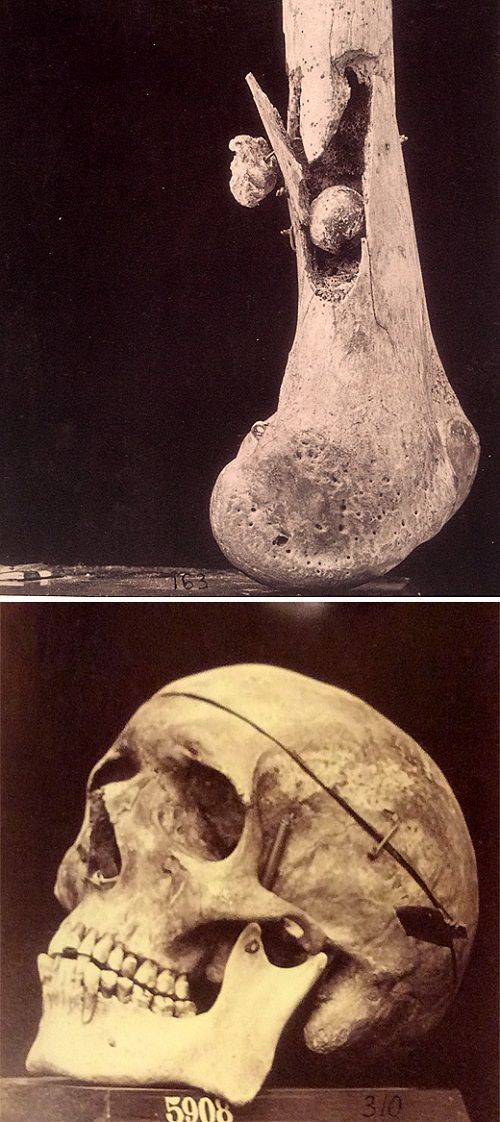
Amputated femur of General Edmund K and skull of Pvt Martin W.
Many of the photographs raise intrigue. There, in the book, is a shot of Susan California Fitt, MD, 1880, dissecting her cadaver; she was the first female physician to practice in Tennessee. And there’s a picture of Joseph Leidy, MD, giving an anatomy lecture to a packed house at the University of Pennsylvania 1886. There are the Doctors Cabot of Harvard 1903. And there’s “an unidentified European medical school circa 1910” that looks awfully like my lecture hall in Edinburgh (except mine didn’t look that modern!)
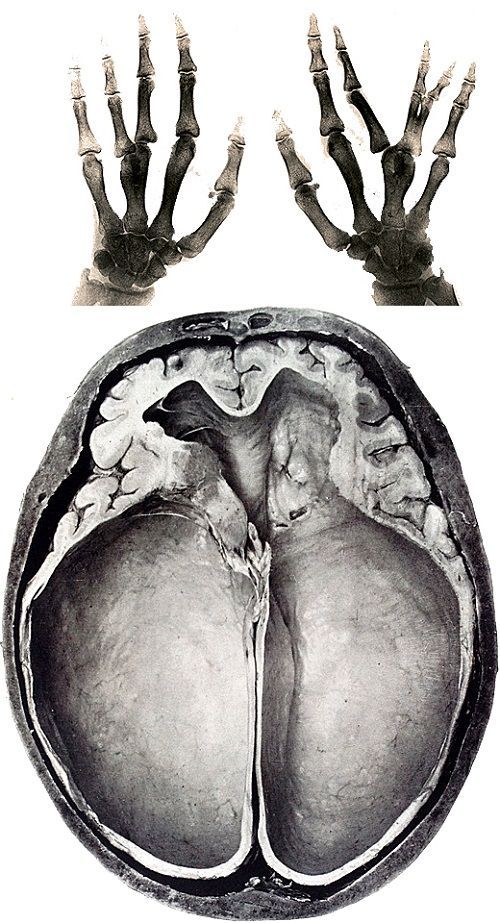
The Burns cover a broad canvas offering us from images of hands with missing metacarpals to a dissected brain showing the compression and loss of brain tissue in hydrocephalus, surely a frightening thought even though the frontal lobes seem less damaged.
There are images showing medical student smoking at a 1905 dissection to disguise the cadaver odor. Maybe things were better by 1917 as that date demonstrates they were now dressing in white coats at one medical school, and wearing oiled aprons at another, and “baker-style” hats at one more school in 1920.
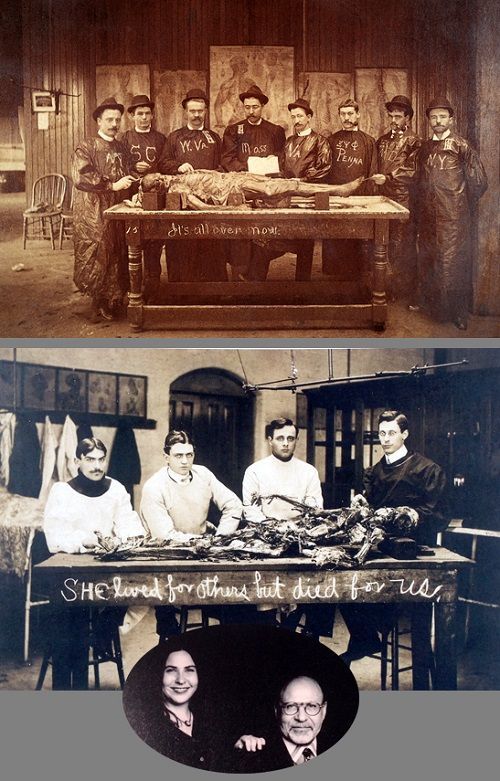
Students and (insert) Elizabeth Burns and Stanley Burns, MD, themselves
Burns says, “The physician, the actor, the explorer, the holy man and the warrior all pose with skulls to convey accomplishment and status.” Understood. And a lot of the medical students in his images surely believe they are Hamlet musing, “Alas, poor Yorick! I knew him well, Horatio!”
Other images in the book show a lighter even frivolous side, namely the gallows humor of medical students. Some of those images would be especially distasteful to the public today. Indeed Burns points out that each generation has had new cultural considerations as we approached the middle of the 20th century.
So we see macabre photographs of students and their cadavers in the dissection rooms captioned with “Doctors in Their Elements” (1870), and “Many are the Joys and Pleasures of Medical Students” (1906) and “A Man’s Usefulness does not End in Death” (1909).
Most of those photographs seem European with students who have pictured themselves in the 1870s holding skulls laid on top of crossed bones as if they were pirates. But there are 2 from Rush Medical College that stand out: Before and After taking the medical degree in 1883 and in 1884. The Rush students look appropriately serious.
So who will find the book interesting?
Well, Civil War historians and forensic pathologists for sure, and sociologists, criminologists, and medical students and academics for sure, and anyone with a deep interest in medical history probably, although I sense today’s medical students are so consumed with studies and the competition to succeed that they are not as interested in Medicine’s past as medical students were a half century ago. But it is our heritage, our legacy. We need to know it!

Top image: Sir William Osler, MD, at work in the Blockley Mortuary, Philadelphia General Hospital, 1886. Bottom image: Osler and staff at the University of Pennsylvania Orthopedic Hospital and Infirmary for Nervous Diseases, 1887
Canadian William Osler, MD, born in 1849 became in 1889 one of the founding professors of Johns Hopkins Hospital. In 1905 he was appointed to the Regius Chair of Medicine at Oxford, England which he held until his death in 1919. Ironically he died of pneumonia, the illness he had once called, “the old man’s friend.”
Osler would tell his students, “Listen to the patient, he is telling you the diagnosis.” Similarly the text in this book is telling the story of the history of medicine maybe more so than the photographs. Stanley Burns has accumulated a lot of medical knowledge in his lifetime and when a new book energizes the 2 Burns to speak, all we have to do is listen.
James M. Edmonson, PhD, Chief Curator of the Dittrick Museum of Medical History, Case Western Reserve University sums up this book in the Foreword by reminding us that most of the photographed plates in this book “were created to be seen by the initiates of the medical profession and not by laypersons.” This is a book where, he says, nothing like it is in print, and he praises the Burns’ ability “to introduce new sub-genres of medical imagery.” True and fascinating, and only for a book reviewer would the absence of an image index beyond the bibliography be disappointing. And—to such a reader—the Appendix and the Enhanced Captions sections are surely a compensating treasure.
STIFFS, SKULLS & SKELETONS
Medical Photography and Symbolism
Schiffer Publishing Ltd.
4880 Lower Valley Road
Atglen, PA 19310
$75.00
ISBN: 978-0-7643-4746-7
The Andersons, who live in San Diego, are the resident travel & cruise columnists for Physician's Money Digest. Nancy is a former nursing educator, Eric a retired MD. The one-time president of the New Hampshire Academy of Family Physicians. Eric is the only physician in the Society of American Travel Writers. He has also written 5 books, the last called The Man Who Cried Orange: Stories from a Doctor's Life.




